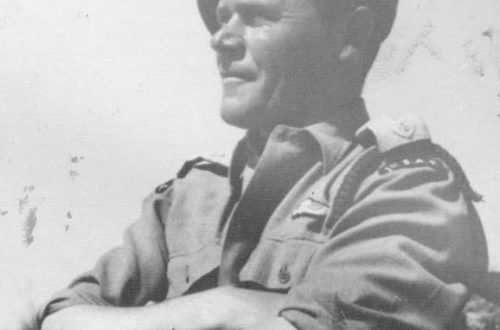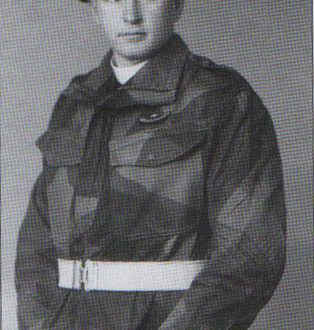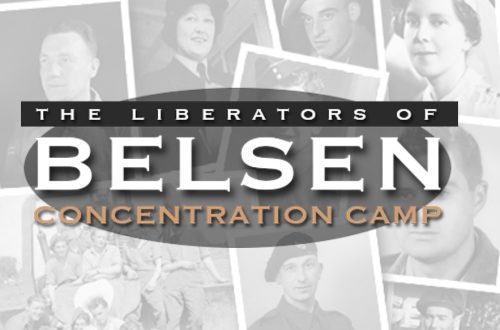The first in…
On April 15, 1945, Lieutenant John Randall, then a 24-year-old SAS officer, was on a reconnaissance mission in northern Germany.
He and his driver were heading down the road to Lüneberg when he noticed a large, imposing iron gate in front of a track leading off into the woods to their left. Curious, Randall decided to investigate, and so discovered one of the most horrifying aspects of Hitler’s Germany.
“We were totally unprepared for what we had stumbled across,” says Randall, now 85, sitting opposite me in the Special Forces Club in London. “I just drove through these gates because they were open. There were one or two totally dejected-looking German guards, but they made no effort to shoot. They didn’t even stop us.”
So when did it dawn on you that this was a concentration camp, I ask. “About 30 yards into the camp, my Jeep was suddenly surrounded by a group of around 100 emaciated prisoners,” recalls Randall. “Most of them were in black-and-white-striped prison uniforms and the rest wore a terrible assortment of ragged clothes. It was the state of these inmates that made me realise that this was no ordinary PoW camp. As to the identity or name of the place, I had no idea. We were two miles from Luneberg Heath where, incidentally, Montgomery signed the German surrender.”
The walls of the Special Forces Club are decorated with photographs of other legendary members of the SAS and SOE. I study Randall as he talks: slightly hawkish, steely-eyed like so many of his regiment, but kind. What happened when you told them you were a British officer? “They went wild,” says Randall, “pleading for food, help, protection and release. I began to get rather alarmed. They were all over us, pulling at my paratroop smock, speaking an array of different languages, including English. There were hundreds of them and there was an overpowering stench, like a farmyard.”
And you weren’t threatened by the Germans at all? “They were totally uninterested. They just stood around watching. We drove off to get out of the melée and then, about 30 yards on, we came across an even more pathetic sight. Next to what I can only describe as a grotesque potato patch were groups of almost naked skeletal figures, pulling clothes off dead bodies and trying to clothe themselves. They hardly noticed our Jeep as we passed. Dead bodies, mainly naked, were strewn around and such was the state of their emaciation that it was difficult to tell whether they were male or female.”
But there was worse to come. Further on, Randall and his driver found a pit, 50ft square, containing a mass of semi-clothed and naked dead bodies of both sexes, lying in contorted positions, one on top of another. “The stench was horrific,” says Randall. “It was a mixture of rotting flesh and excrement – a smell that I couldn’t get rid of for weeks. I would wake in the night with this ghastly smell in my nose.”
After 30 minutes alone in Belsen, Randall and his driver were joined by another SAS Jeep carrying the squadron commander, Major John Tonkin, and his squadron Sergeant-Major, Reg Seekings, an SAS veteran of North Africa, Sicily, Italy and France. “Seekings was a very tough man,” Randall says. “He had been with the regiment almost since it was formed and had been an army boxing champion when in the Guards.”
As the four SAS men stood looking at this pitiful and horrifying sight, they were approached by Josef Kramer, the camp commandant, and a woman in a dark blue uniform. “Kramer introduced himself and the woman, Irma Grese, responsible for the female prisoners, and to our astonishment offered us a guided tour of the camp,” says Randall. “We followed them. We pushed open the door of one of the huts and were overpowered by the stench. Emaciated figures peered out at us, in fear and surprise, from the rows of bunks. Lying among them, on the same bunks, were dead bodies.”
As they came out of one of the huts, the four men saw a camp guard using the butt of his rifle to beat up a prisoner. “Reg Seekings turned to John Tonkin, and asked permission to intervene and teach the guard a lesson.” This was granted without hesitation. “So Reg went over and hit the guard in the face. He got up and was then knocked out by another punch to the head. Then Tonkin ordered Kramer and Grese into the guardroom, and said, ‘We are now in charge, not you, and any guard who attempts to treat a prisoner with brutality will be punished.’
None of the SAS members saw Kramer or Grese again. They were later arrested, tried and executed for war crimes. As Randall continues his story, I realise that despite his self-control and professionalism, this interview is a terribly emotional experience for him. Describing the sights, noises and especially the smells brings Belsen back to him. But he keeps going. “I believe people of my age should express their own sentiments,” he says, “and I can never forgive the Germans for what they did. I have met the most charming and intelligent Germans since the war, but I will not accept that they knew nothing about the concentration camp atrocities. Worse still, there were those who did know and chose not to do anything about it. I was only 24 years old when I went into Belsen. It was a tremendous shock to a young man brought up in a protected environment. I was very impressionable and, as a result, have had a lifelong hatred of brutality and injustice – all the things that the Nazi regime personified.
“The world lost some of the finest and brightest individuals on earth,” says Randall. “And what hurts me is the fact that they cannot be brought back. It is beyond comprehension that the Germans sought to exterminate such a wonderful race, which has contributed so much over the centuries. They will never recover from this barbarity. We must never forget what the Jews suffered.”
They certainly don’t forget him. On Holocaust Day that year, Randall was presented to the Queen in St James’s Palace. As he stood in line waiting with other liberators and survivors of Belsen, a woman next to him turned and said: “You saved my life. When the British arrived in Belsen I was 15. I believe I had only about two days left to live. You came just in time.” On Wednesday he is going to the Holocaust Survivors Centre in Hendon to meet more of those who lived through Belsen. “For me,” says Randall, “meeting them completes the circle. But right now,” he looks up at me, “I think we need a drink.”
10,906 total views



